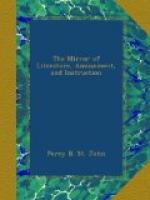In the thirty-third year of the reign of Henry VIII. it appears that Wingfield Manor was in the possession of the Earl of Shrewsbury; and in the time of Queen Elizabeth, the Earl of Shrewsbury held in his custody here the unfortunate Mary, Queen of Scotland. Her suit of apartments, tradition informs us, was on the west side of the north court. This, in the memory of persons living but a few years since, was the most beautiful part of the building: it communicated with the great tower, whence it is said the ill-starred captive had sometimes an opportunity of seeing the friends approach with whom she held a secret correspondence; and “this tradition appears to have been founded upon good authority."[2] It is inferred that her captivity at Wingfield commenced in 1569, in which year an attempt was made by Leonard Dacre to rescue her; after which, Elizabeth, becoming suspicious of the Earl of Shrewsbury, under pretence of his lordship’s being in ill health, directed the Earl of Huntingdon to take care of the Queen of Scots in Shrewsbury’s house; and her train was reduced to thirty persons. This event happened the year after Mary was removed from Bolton Castle, in Yorkshire, to Tutbury Castle, in Staffordshire, and placed under the care of the Earl of Shrewsbury. Her captivity at Wingfield is stated to have extended to nine years; but it is improbable that so large a proportion of the time she was in the custody of this nobleman, should be spent here: for it is well known, that from 1568 to 1584, she was at Buxton, Sheffield, Coventry, Tutbury, and other places, and, if her confinement here continued so long, it must have been with many intervals of absence.
[2] Antiquarian and Topographical Cabinet, vol. i.
The Manor-House continued to be the occasional residence of the Shrewsburys till the death of Earl Gilbert, in the year 1616, who dying without male issue, the whole of his estates in this part of the kingdom descended to his three daughters and co-heirs by marriage, and their descendants, till one of the latter, the Hon. Henry Howard, becoming Duke of Norfolk, sold his portion to different tenants; and in the year 1666, we find Mr. Emanuel Halton resident at the Manor-House. He was a man of considerable literary and scientific attainments, as well as of good family, his father being sheriff of Cumberland in 1652. Being employed




